

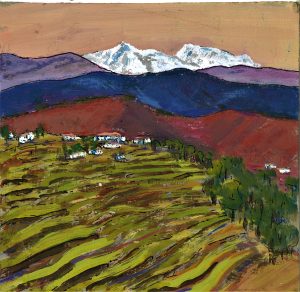 WE made it to the Uttarakhand region of the Himalayan hills on the north-eastern reaches of India in the nick on the map bordered by Nepal and Tibet. At about 150 km south of the highest peak in India, the 21,000 feet of Nanda Devi, loomed on the horizon in the gin clear air as though it was a short walk away from our mere 7000 feet hillocks.
WE made it to the Uttarakhand region of the Himalayan hills on the north-eastern reaches of India in the nick on the map bordered by Nepal and Tibet. At about 150 km south of the highest peak in India, the 21,000 feet of Nanda Devi, loomed on the horizon in the gin clear air as though it was a short walk away from our mere 7000 feet hillocks.
Steep and intriguing hills rolling into the distance alive with activity. With eagles souring and woodpeckers sounding, the local doves and great barbetts make the most sound in the short twilight when the temperature changes markedly – 25 in the day to below 10 degrees at nightfall.The villages stand out with their white painted fronts, blue window surrounds and animals in the yard. the house cow, the goats and the oxen munching slowly.
For these are the Kumaon Hills which are unspoilt, extensive and dramatic.
Rhododendron forest and tall cedars give way to many many tall pines which compete in their way with the dense himalayan oaks on the ridiculously steep hillsides, undisturbed for mile after mile, and only occasionally the benign farming intervenes in places where the water is secure and the soil is good,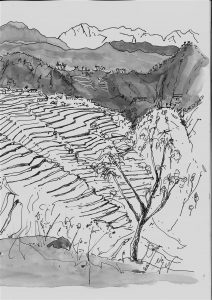 and this scenery gives a wildness within the thin blue air that is breathtaking. The people smile and the children are happy.
and this scenery gives a wildness within the thin blue air that is breathtaking. The people smile and the children are happy.
The simple terraced farming with wheat, garlic, onions, potatoes, spinach, clings to the extraordinarily steep slopes meaning everything has to be done by hand other than the occasional oxen-pulled plough. In the wet bottoms rice is eeked out with intricate flooding systems to catch the spate waters. Fodder grasses are stored aloft in trees; children and their mothers go in search of oak leaves for the few house animals, and others for firewood for their continually burning stoves.
And in the valleys lightly flapping scarecrows and village cricket punctuate the immaculate strips of vegetables, whet and rice
Such hard work to keep the daily routine where house cows pervade in the front yards, and women carry everything from muck to firewood on their heads and men go out to manual labour for a wage to bring home. All this made more difficult by the distances required on foot and the steepness of the terrain not to mention the monkeys stripping the crops. And then there is a shout ‘banar,banar……banar’ as our local guide throws stones at the rampaging banars in an attempt to move them on.
So we move onto our lodgings at Ganghet – a simple bungalow manned by marvellous locals who have immaculate manners and give us quiet simple service with no qualms – and such grace.
The far off thunderstorms bounce around the hills but leaves us alone and help clear the air for the morning light before it goes too flat in the 30 degree sun straight overhead.
and on our way back we glimpse the white tops from a vantage point where the children play cricket on a level prospect above the village.
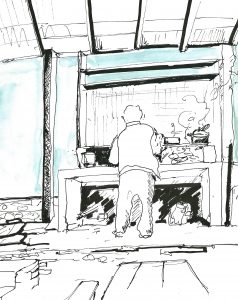
and not before stopping to have tea made to order on the side of the road
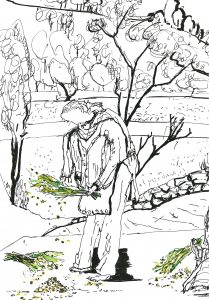
or witnessing dexterous manipulation of the corriander plant to amass a nice pile of seed for the pot and next years crop.
Emma Horne Travel is where you need enquire if you want some good Indian travel advice from a family devoted to such activity ……. and I can’t recommend the Kumaon more highly.
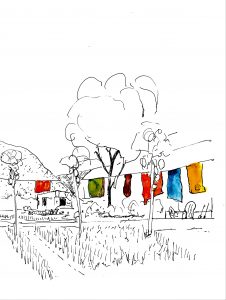 oh and washing is everywhere – and the on the end of my bed
oh and washing is everywhere – and the on the end of my bed